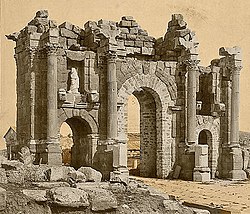Mesarfelta
Appearance

Mesarfelta was a
History
The historic Mesarfelta is believed to be what are now the ruins of El-Outaïa or those of Tolga, Henchir-El-Ksar,[1] or may be Qastilya in Algeria[2] (according to "Three North-African Topographical Notes (Islamic-Roman)").
The city is believed to have been constructed as a fortification by the
A barrier called Fossatum Africae, which marked the frontier between the territory of the Roman Empire and other lands, ran through Mesarfelta.[4]
The city disappeared after the Muslim conquest in the second half of the 7th century.
Bishopric
The city of Mesarfelta was the seat of an ancient
Council of Carthage (411)
.
Ancient bishops
Titular bishops of Mesarfelta
Source:[6]
- William Edward McManus 1967–1976
- Louis-Albert Vachon 1977–1981
- Basile Tapsoba 1981–1984
- Joseph Paul Pierre Morissette1987–1990
- Michael Angelo Saltarelli[7] 1990–1995
- Antonio Menegazzo, M.C.C.I. 1995-2019
See also
- Mauretania Caesariensis
- Caesarea
- Thamugadi
- Lambaesis
References
- ^ ISBN 978-88-209-9070-1), p. 929
- JSTOR 4054839.
- ISBN 9781134707393.
- ISBN 0-415-26314-X.
- ^ Joseph Bingham, Origines Ecclesiasticae; Or the Antiquities of the Christian Church and Other Works: In Nine Volumes, Volume 3 p236.
- ^ "Mesarfelta (Titular See)". Catholic-Hierarchy.org. October 12, 2009. Retrieved 20 December 2009.
- ^ Gabriele, Michael C. (October 14, 2009). "Bishop Saltarelli, 77; Son of Archdiocese". The Catholic Advocate. Retrieved 20 December 2009.
Bibliography
- J. Baradez (1949). Gemellae. Un camp d'Hadrien et une ville aux confins sahariens aujourd’hui ensevelis sous les sables. Revue Africaine v. 93 p. 1-24.
- P. Trousset (2002). Les limites sud de la réoccupation Byzantine. Antiquité Tardive v. 10, p. 143-150.

